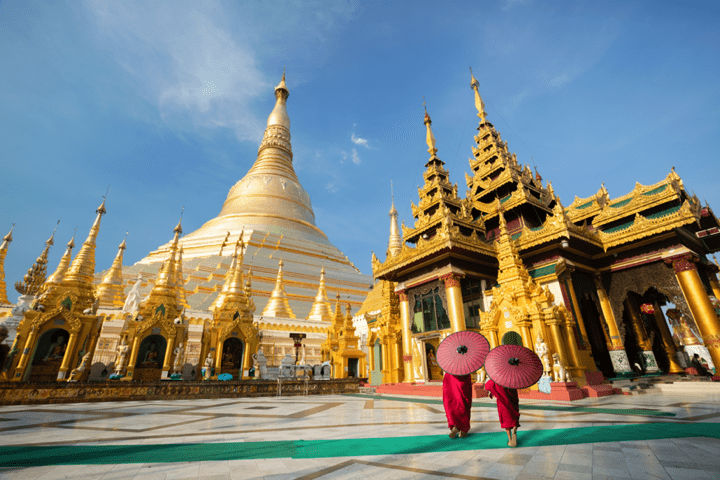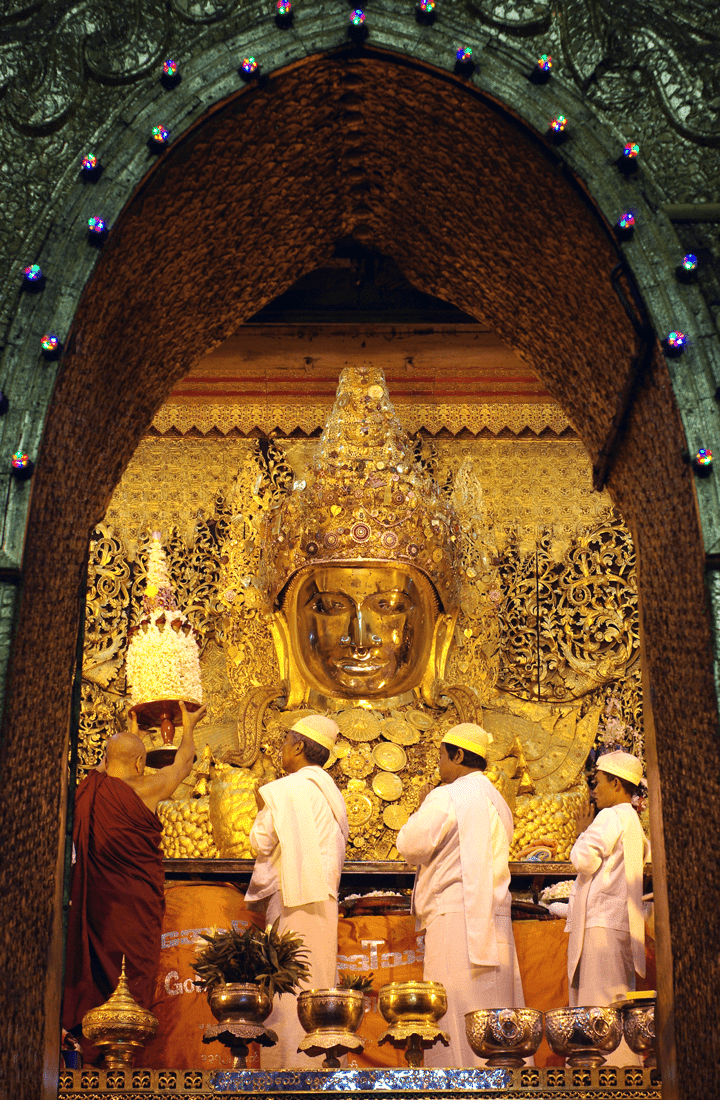Huong Quynh
Myanmar is home to famous pilgrimage sites in a land devoted to pagodas and Buddhism.
Myanmar, where 90% of the population is Buddhist, is a land of pagodas. Off the thousands of pagodas scattered all over the country, three are considered particularly sacred: Golden Pagoda of Shwedagon, Golden Rock Pagoda Kyaikhtiyo and Mahamuni Pagoda.

Splendid And Sparkling Shwedagon
Shwedagon means “Golden Stupa” in Burmese. Debates still heat up over the exact date of origin of this pagoda, as experts try to piece together the details from a mix of archeological evidence and folk stories. It’s assumed that this pagoda in Yangon underwent numerous construction and restoration periods. From an initial height of eight meters, the pagoda was heightened various times to 20 meters, then 40, 80 and now 98 meters. The whole stupa is gilded with a dozen tons of gold donated by successive generations of rulers and common people of Myanmar. The towering stupa and its nearly 80,000 diamonds, sapphires and rubies studded on its finial make Shwedagon the most famous pagoda of Myanmar. Most Burmese people wish to visit the Golden Pagoda at least once in their lifetime because it is the “Mecca” of Buddhism in Myanmar. However, Shwedagon Pagoda is sacred not because it is buried in countless jewelries all over the stupa, but because it was the foundational site of Buddhism as well as home to 8 hair strands of Sakyamuni Buddha. This relic of Buddhist hair strands was registered as a Burmese national treasure.

Kyaikhtiyo (Golden Rock) Pagoda
Over 200 kilometers away from Yangon, the Kyaikhtiyo Pagoda is a masterpiece featuring incredible harmony between nature and the esoteric doctrines of the Buddhist realm. Kyaikhtiyo Pagoda is nestled on an egg-shaped rock that perches precipitously on a hilly mountain rising over 1,000 meters. The Burmese people assume that the timeless resilience of this pagoda, which is over 2,000 years old, is thanks its hosting the relic of hair strands of Buddha.
As legends has it, Buddha in his lecturing expedition in this land entrusted a hair strand to a monk and told him to seek out a rock that resembled a human head and place his hair strand there so that Buddhist doctrines would be widespread. Before his demise, the hermit wished this sacred gift to be worshipped, so entrusted the strand to a king who was his adoptive son. The king, named Tisa, found this sacred mountain and built Kyaikhtiyo Pagoda to host the relic of Buddha atop the stupa. As a result, the name of this pagoda is associated with this legend, as Kyaikhtiyo means the Hermit’s Head in Burmese.

Serene Mahamuni Pagoda in the former capital
The sacred and serene pagoda in the former capital of Mandalay is the last of the three most important pilgrimage sites in Myanmar. The reason why Burmese pilgrims put trust in sacred Mahamuni is that it has the most authentic statue of Sakyamuni Buddha when he was present on earth.
The statue, hosted in the main hall, stands nearly 4m tall and is gilded and studded with numerous gemstones. Every day, Buddhist followers from throughout the country come practicing rituals and continue to gild the precious statue. To admire the Buddha statue and the surroundings from the vast and airy main hall is a great pursuit that visitors seek to find peace of mind in Mandalay.
Burmese aside, visitors who travel to these sacred Buddhist realms can not only marvel at their incredible architecture, but also contemplate the powerful messages of Buddhist doctrine in our everyday lives.










